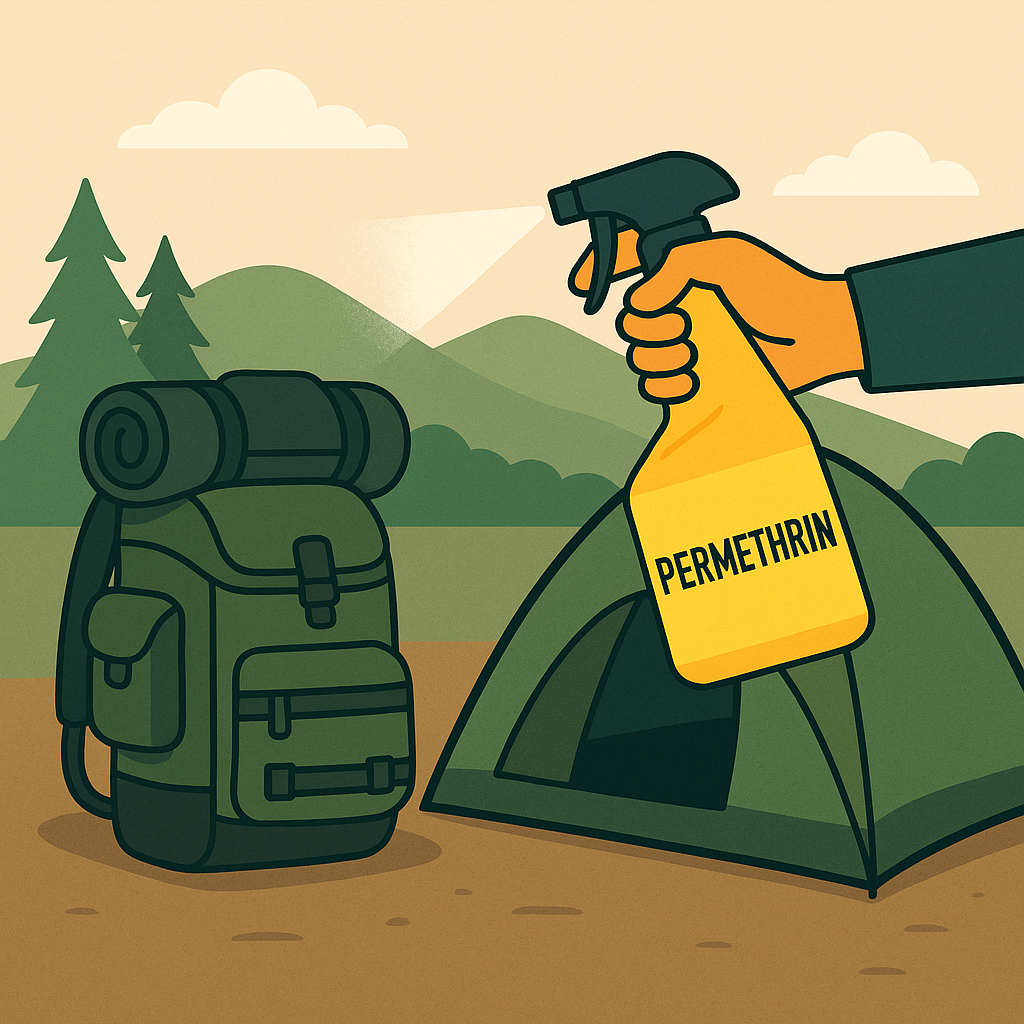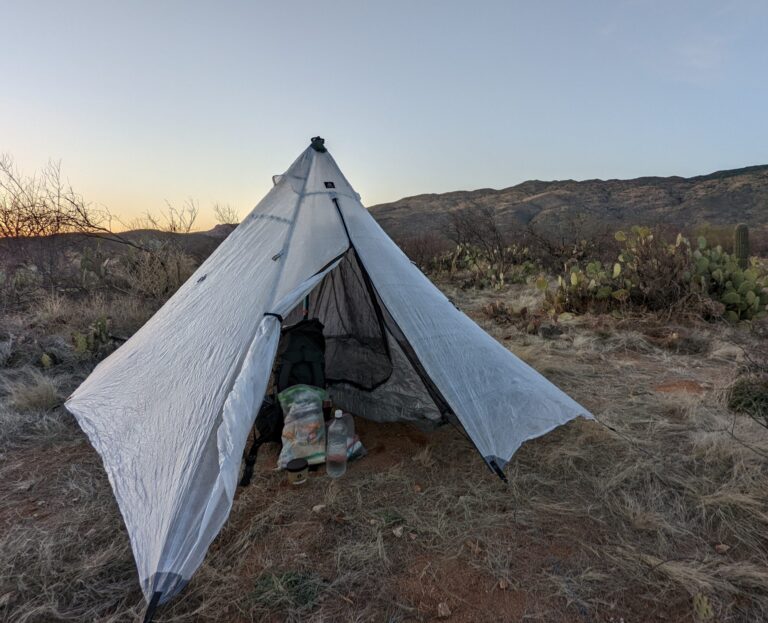How to treat your gear with Permethrin
🪲 When you’re deep in the wild, bugs aren’t just annoying — they’re dangerous.
To understand how repellents and gear protection work together, start with The Ultimate Guide to the Best Mosquito Repellents in 2025.
This post contains affiliate links. I may earn a small commission at no extra cost to you. Learn more.
What Is Permethrin?
Permethrin for clothing is a 0.5% fabric treatment that bonds to fibers and repels/kills ticks and mosquitoes on contact—apply it to clothes and gear, never to skin. It’s not a skin repellent—permethrin works by treating clothing and equipment so bugs drop off or die when they touch it. Most consumer sprays made for clothing are 0.5% permethrin, which is the sweet spot for safety and effectiveness on fabrics.
Use it on: socks, pant cuffs, long-sleeve shirts, hats, gaiters, shoe/boot fabric (not leather), backpack straps/hip belt, and tent/hammock mesh or entry points.
What it won’t do: it’s not a force field—still use a skin repellent (DEET, picaridin, etc.) on exposed skin; don’t apply to underwear or directly to skin.
Longevity: a DIY fabric treatment typically lasts about 6 weeks or 6 washes (whichever comes first).
Safety (topline): apply outdoors or in strong ventilation, keep pets (especially cats) and water sources away during application, and let items dry completely before wearing or packing.
Why Treat Your Gear?
-
Layered Protection: Adds a barrier on clothing and equipment, reducing the need to reapply skin repellent constantly.
-
Tick Defense: Greatly lowers the chance of ticks attaching to your ankles, pant legs, backpack straps, and tent edges.
-
Long-Lasting: A single treatment lasts about 6 washes or 6 weeks—whichever comes first.
What to Treat
-
Clothing: Hiking pants, shorts, long-sleeve shirts, socks, hats, gaiters
-
Footwear: Fabric sections of boots or trail shoes (avoid soaking leather or waterproof membranes)
-
Backpacks & Straps: Hip belt, shoulder straps, any area that brushes foliage
-
Tents & Hammocks: Vestibule edges, mesh panels, underquilts—avoid waterproof DWR coatings on shelters
-
Sleeping Bags & Liners: Outer shell of sleeping bag or hammock underquilt
Step-by-Step Treatment
-
Choose a Permethrin Spray for Fabrics
Use a permethrin product labeled for clothing (usually 0.5 %–1 % concentration). -
Pick a Well-Ventilated Area
Treat gear outdoors or in a garage with good airflow. Wear disposable gloves and a mask if available. -
Lay Gear Flat & Pre-Flip Clothing
-
For garments: turn each item inside out first, so you can treat both sides.
-
For backpacks or tents: spread panels or straps flat, avoiding folds.
-
-
Apply a Light, Even Mist
-
Hold the can about 6–8 inches from fabric.
-
Spray until fabric is damp to the touch—do not soak (no dripping).
-
Pay special attention to cuffs, ankles, collar seams, backpack straps, and tent vestibule edges.
-
-
Let Everything Dry Completely
-
Hang clothing and gear in a shaded, breezy spot.
-
Dry time is usually 2–4 hours (depending on humidity and airflow).
-
Do not pack or wear treated items until fully dry.
-
-
Store Treated Items Properly
-
Once dry, place clothing in sealed plastic bins or bags.
-
Keep treated tents/sleeping bags in a cool, dark place away from direct sunlight.
-
Safety Tips & Precautions
-
Avoid Skin Contact While Spraying: Permethrin liquid can irritate skin before it dries. Always wear gloves.
-
Do Not Spray Waterproof Coatings: On rain jackets or tent rainflies, avoid the outer waterproof membrane; focus on mesh and seams instead.
-
Keep Away from Children & Pets: Store permethrin spray out of reach. Once gear is dry, it’s safe to handle.
-
Protect Surroundings: Cover grass, flowers, or surfaces you don’t want sprayed—permethrin runoff can harm beneficial insects.
Washing & Reapplication
-
Initial Cure: Wait 6–8 hours after spraying before the first wash.
-
Washing Tips:
-
Hand‐wash gently in cold water with mild detergent, then line-dry.
-
Or use a machine’s gentle cycle (cold water) without bleach or fabric softener, then tumble dry low or line-dry.
-
-
Reapply: After about 6 washes or 6 weeks (whichever comes first), retreat all treated items. If one area sees heavy wear (e.g., pant cuffs), you can spot-spray just that section.
Field Strategy: Max Protection With Less Hassle
-
Combo plan: Permethrin-treated clothing + picaridin/DEET on exposed skin = fewer bites, fewer ticks. US EPA
-
Socks & shoes first: Treated socks/shoes massively reduce tick bites; make them priority #1. sawyer.com
-
Dress smart: Light-colored pants, pants-into-socks, sleeves down, hat on.
-
Daily tick checks: Groin, waistband, armpits, behind knees, hairline, and around socks.
Advanced Notes (For Power Users)
Membranes & rainflies: Most brand-name 0.5% sprays are fabric-safe (even membranes) once dry, but bugs typically don’t bite through a taut rainfly. If you’re worried about coatings, test a hidden patch and focus on mesh/seams where contact happens. sawyer.com
Immersion/soak methods: Only use label-approved formulations for clothing. If you want longer-lasting, uniform treatments, consider factory-treated garments or send-in services instead of home-mixing concentrates.
Quick FAQ
Q: When is it effective?
A: As soon as the fabric is fully dry; ideally allow extra cure time before packing. CDC
Q: Will it hurt my tent or jacket?
A: Most 0.5% sprays are fabric-safe when used correctly. Test a small area first; focus treatment where contact occurs (mesh, doors, hems) rather than soaking entire rainflies. sawyer.com
Q: Can I treat leather or fully waterproof boots?
A: Lightly mist fabric panels/laces only; don’t saturate leather or membranes.
Q: Is it safe around kids and during pregnancy?
A: Factory-treated clothing has been reviewed with no significant risk when used as directed. As always, follow labels and standard repellent guidance. US EPA
Q: Cats in the house — what then?
A: Treat outside, let items fully dry before bringing them in; keep drying items away from pets. Cats are notably more sensitive to permethrin. National Pesticide Information Center
Q: Do I still need skin repellent?
A: Yes — permethrin protects covered skin. Use a skin repellent on exposed skin.
Once your gear’s protected, it’s time to handle personal hygiene in the field.
Read The Ultimate Guide to Staying Fresh While Camping (No Shower? No Problem!) next for smart ways to stay clean and comfortable.
Wrap-Up
Treating your gear with permethrin is one of the simplest, most effective ways to stay bite-free. Follow these steps, use common safety precautions, and remember to reapply after 6 washes or 6 weeks. With permethrin-treated clothing and equipment, you’ll spend less time worrying about insects and more time enjoying the outdoors.


